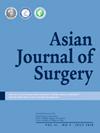Cervical mediastinoscopy plus robot-assisted transhiatal esophagectomy (CMRTHE) for advanced esophageal cancer after neoadjuvant chemoradiation therapy: A technical note with video vignette
IF 3.8
3区 医学
Q1 SURGERY
引用次数: 0
Abstract
Technique
Surgical management of esophageal cancer often involves a transthoracic approach. However, many patients have reduced pulmonary reserve due to a history of smoking. One-lung ventilation during transthoracic procedures complicates anesthesia and increases the risk of postoperative pulmonary complications. To address this, we developed cervical mediastinoscopy plus robot-assisted transhiatal esophagectomy (CMRTHE) as a nontransthoracic alternative. This novel procedure was further applied to patients with esophageal cancer after neoadjuvant concurrent chemoradiation therapy (CCRT). First, transcervical mediastinoscopy is applied, where the cervical/thoracic esophagus, left recurrent laryngeal nerve, and lymph nodes are carefully dissected through a single left neck incision. The operation then transitions to a transhiatal robotic approach following abdominal lymphadenectomy and stomach mobilization. Once the transcervical and transhiatal planes connect, CMRTHE is completed without one-lung ventilation. A video vignette is included to demonstrate the technique.
Results
A 58-year-old male with cT3N3 middle thoracic esophageal squamous cell carcinoma underwent neoadjuvant CCRT followed by CMRTHE. Despite some adhesions, the procedure was successfully completed and required 234 min for the transcervical mediastinoscopy and 71 min for the transhiatal robotic procedure. Blood loss was 220 mL. Pathology revealed a 2.5-cm residual tumor with clear margins, and none of the 21 lymph nodes showed metastasis. The patient's postoperative course was uneventful, with normal vocal cord function, and he was discharged on day 7.
Conclusions
CMRTHE is a technically feasible procedure for advanced esophageal cancer after neoadjuvant CCRT. However, further validation in a larger patient cohort is needed to assess its peri-operative and long-term oncological outcomes.
新辅助放化疗后晚期食管癌的宫颈纵隔镜联合机器人辅助经裂口食管切除术(CMRTHE):一个带有视频的技术说明
食管癌的外科治疗通常包括经胸入路。然而,由于吸烟史,许多患者肺储备减少。经胸手术中单肺通气使麻醉复杂化,并增加术后肺部并发症的风险。为了解决这个问题,我们开发了颈纵隔镜检查加机器人辅助的经胸廓食管切除术(CMRTHE)作为非经胸的替代方法。这种新方法进一步应用于新辅助同步放化疗(CCRT)后的食管癌患者。首先,应用经颈纵隔镜检查,其中颈/胸食管、左喉返神经和淋巴结通过一个左颈部切口仔细清扫。随后,在腹部淋巴结切除术和胃动员后,手术过渡到经裂口机器人入路。一旦经颈和经腭平面连接,无需单肺通气即可完成CMRTHE。包括一个视频短片来演示该技术。结果58岁男性cT3N3型中胸食管鳞状细胞癌行新辅助CCRT + CMRTHE。尽管有一些粘连,手术还是成功完成,经颈纵隔镜检查需要234分钟,而经峡道机器人手术需要71分钟。血量220 mL。病理显示肿瘤残留2.5 cm,边缘清晰,21个淋巴结未见转移。患者术后过程顺利,声带功能正常,于第7天出院。结论scmrthe是晚期食管癌新辅助CCRT后技术上可行的治疗方法。然而,需要在更大的患者队列中进一步验证,以评估其围手术期和长期肿瘤预后。
本文章由计算机程序翻译,如有差异,请以英文原文为准。
求助全文
约1分钟内获得全文
求助全文
来源期刊

Asian Journal of Surgery
医学-外科
CiteScore
3.60
自引率
31.40%
发文量
1589
审稿时长
33 days
期刊介绍:
Asian Journal of Surgery, launched in 1978, is the official peer-reviewed open access journal of the Asian Surgical Association, the Taiwan Robotic Surgery Association, and the Taiwan Society of Coloproctology. The Journal is published monthly by Elsevier and is indexed in SCIE, Medline, ScienceDirect, Scopus, Embase, Current Contents, PubMed, Current Abstracts, BioEngineering Abstracts, SIIC Data Bases, CAB Abstracts, and CAB Health.
ASJSUR has a growing reputation as an important medium for the dissemination of cutting-edge developments in surgery and its related disciplines in the Asia-Pacific region and beyond. Studies on state-of-the-art surgical innovations across the entire spectrum of clinical and experimental surgery are particularly welcome.
The journal publishes original articles, review articles, and case reports that are of exceptional and unique importance. The journal publishes original articles, review articles, and case reports that are of exceptional and unique importance.
 求助内容:
求助内容: 应助结果提醒方式:
应助结果提醒方式:


